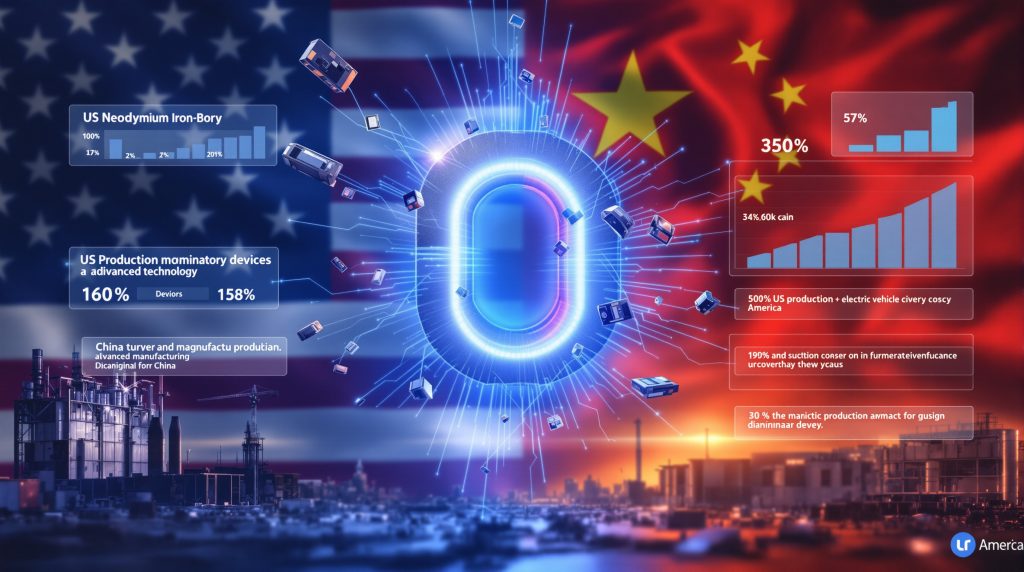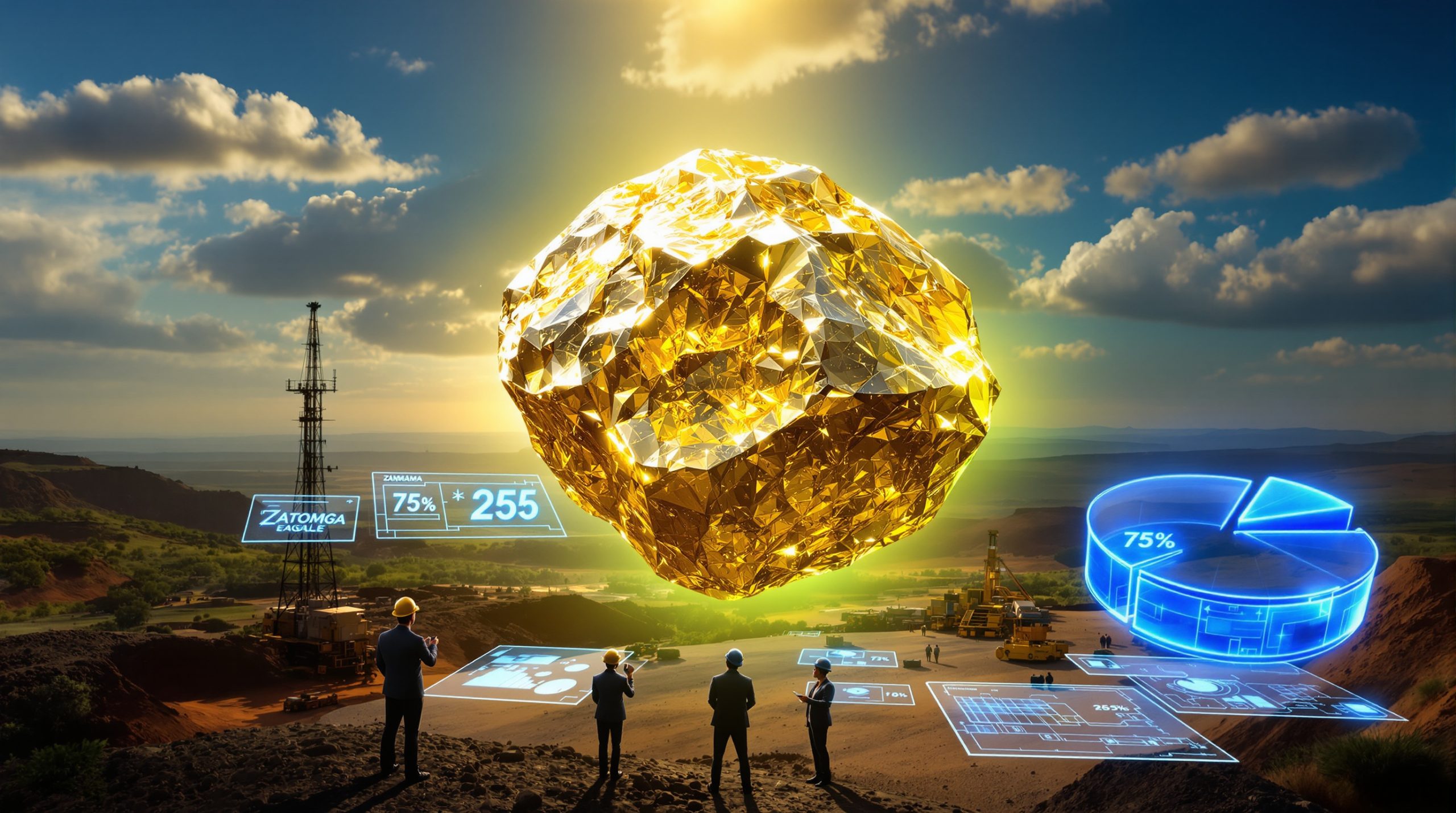The American Magnet Manufacturing Renaissance: Building Domestic Supply Chains
The United States faces a critical challenge in rebuilding its once-thriving magnet manufacturing industry. With zero domestic production of rare earth magnets despite an annual demand of approximately 20,000 tons, America's technological future and national security hang in the balance. This article explores how to make magnets in America, the obstacles that must be overcome, and the path forward for this essential industry.
The Three-Decade Decline of American Magnet Production
America's magnet manufacturing capabilities have experienced a dramatic decline over the past three decades. The downfall began when Chinese competitors entered the market with significantly lower prices, effectively suffocating American processing operations that couldn't compete on cost.
A pivotal moment in this decline occurred when General Motors shuttered Magnequench and dismantled their Delco parts division, transitioning to just-in-time logistics instead of maintaining inventory. This corporate decision exemplified the broader shift away from domestic production capabilities toward globalized supply chains optimized for cost rather than resilience.
Simultaneously, the original bastnaesite operation at Mountain Pass in California closed, leaving the United States with a critical gap in both production infrastructure and technical expertise. This facility had been America's primary source of light rare earth elements, essential components in high-performance magnets.
The Current State of U.S. Magnet Manufacturing
The current reality is stark: there is no heavy rare earth production in the Americas and no heavy rare earth separation plant to produce the high-purity oxides necessary for making rare earth metals required for high-coercivity magnets. This gap undermines ambitious national goals related to critical minerals transition, industrial reshoring, and technological advancement in artificial intelligence.
Jack Lifton, Co-Chair of the Critical Minerals Institute, states: "There is no heavy-rare earth production in the Americas at this point, and there is no heavy rare earth separation plant to produce the high-purity oxides necessary for making the rare earth metals necessary for high-coercivity magnets."
Despite being the world's largest economy, the United States relies entirely on imports for approximately 20,000 tons of rare earth magnets consumed annually. This complete dependence on foreign suppliers—primarily China—represents both an economic vulnerability and a national security risk.
Why Magnets Are Critical to America's National Security
Strategic Applications of Rare Earth Magnets
High-performance magnets, particularly those containing rare earth elements like neodymium, dysprosium, and samarium, are essential components in defense systems, clean energy technologies, and advanced computing infrastructure. These specialized magnets enable technologies that are fundamental to modern warfare and critical infrastructure.
- Precision guidance systems in missiles and smart munitions
- Radar and sonar equipment for surveillance and detection
- Communication systems for secure military networks
- Electric motors in submarines and unmanned vehicles
- Aircraft generators and control systems
Each of these applications requires magnets with specific performance characteristics that cannot be easily substituted with alternative technologies. The unique properties of rare earth magnets—their exceptional strength-to-weight ratio and resistance to demagnetization—make them irreplaceable in many critical systems.
The National Security Implications
The lack of domestic magnet manufacturing represents a significant national security vulnerability. While military applications might represent only about 5% of domestic demand, these applications are mission-critical to defense capabilities.
Defense planners recognize this vulnerability and have shown willingness to bankroll capacity at virtually any cost, prioritizing capability over price considerations. The Department of Defense has classified rare earth magnets as strategically essential materials through a critical minerals order, acknowledging their irreplaceable role in modern defense systems.
"The military is fine—capacity matters more than price—but that's maybe five percent of domestic demand," notes Lifton, highlighting the disconnect between defense priorities and commercial market realities.
This vulnerability extends beyond direct military applications to include critical infrastructure. Power grids, water systems, and communications networks all rely on technologies that incorporate high-performance magnets. A disruption in the supply chain could have cascading effects across essential services.
The Complex Challenges in Rebuilding U.S. Magnet Manufacturing
The Loss of Institutional Knowledge
Perhaps the most significant barrier to rebuilding America's magnet manufacturing capabilities is the loss of institutional knowledge. As manufacturing moved overseas, so did the expertise required to design, build, and operate production facilities.
"You cannot simply, with money, create institutional memory. That's silly," explains Lifton. When asked by the Department of Defense where to recruit expertise for rebuilding magnet manufacturing capabilities, his response was blunt: "cemeteries, assisted-care homes, and guys like me."
This stark assessment highlights a critical problem: the chemists, metallurgists, and process engineers who once mastered these technologies have largely retired or passed away. The knowledge transfer that typically occurs in functioning industries has been interrupted by decades of inactivity.
The Complex Supply Chain Requirements
Creating a magnet isn't simply a matter of mining rare earth materials. It requires a complete supply chain that extends far beyond extraction:
- Mining of rare earth-containing ores
- Separation of individual rare earth elements
- Conversion to pure metal forms
- Alloying with precise formulations
- Magnet manufacturing with specialized equipment
- Machining and finishing to precise specifications
- Quality control with advanced testing methods
While MP Materials' Mountain Pass and Lynas Rare Earths' Mount Weld represent two of the world's only truly primary rare earth mines, ore extraction is merely the first step. The process continues with separated oxides feeding metal makers, followed by alloys feeding magnet plants. Each stage requires specialized engineering expertise.
The absence of any single link in this chain renders the entire system non-functional. America currently lacks multiple critical components in this production sequence.
The Economic Hurdles
Price competition remains a significant obstacle to rebuilding domestic production. Even with substantial tariffs, Chinese magnets maintain a competitive edge due to decades of infrastructure development, government support, and accumulated expertise.
Industry analysts suggest that at a 100% tariff, Chinese magnets would still be cheaper, and even at 200%, the economic equation remains uncertain. This reality has led some American manufacturers to openly commit to "buy from China forever" as long as prices remain below $100 per kilogram.
The economics are further complicated by the fact that establishing domestic production requires massive upfront investment with uncertain returns. Private capital has been reluctant to make these investment opportunities without guaranteed long-term demand and protection from international competition.
Global Competition in Magnet Manufacturing
Japan's Strategic Approach
Japan has developed a more resilient rare earth supply chain by implementing a comprehensive national strategy. They funnel light rare earth feedstock from Australia's Lynas into domestic metal production, creating a supply line independent of Chinese sources.
Additionally, Japan has co-financed a heavy rare earth separation plant in France, demonstrating a commitment to securing every link in the supply chain. This investment ensures access to the heavy rare earth elements needed for the highest-performance magnets.
"Japan is taking care of Japan… They're not interested in helping us except to sell us things," notes Lifton, highlighting the reality that even allies prioritize their own supply security.
Japanese companies like Hitachi Metals and TDK have maintained magnet manufacturing expertise through continuous operation, avoiding the knowledge gap that plagues American efforts. Their strategic approach combines corporate capability with government support in a coordinated national effort.
Other Nations' Self-Sufficiency Efforts
Beyond Japan, other nations are pursuing self-sufficiency in the rare earth supply chain:
- South Korea is developing domestic processing capabilities to support its electronics and automotive industries
- India is methodically building complete vertical integration from mining through separation, metals, and magnets to support its growing electric vehicle industry
- Malaysia maintains strategic relationships with both Chinese and Australian mining operations, hedging its position in the global supply chain
- European Union has launched the European Raw Materials Alliance (ERMA) to develop supply chain resilience
These international efforts demonstrate that the competition for rare earth magnet manufacturing is intensifying globally, with nations recognizing the strategic importance of these materials.
China's Dominant Position
China maintains overwhelming dominance in the global magnet manufacturing industry, controlling approximately 85-90% of global production capacity. Their integrated supply chain spans from mining operations to finished magnet production.
This dominance stems from several factors:
- Early investment in rare earth mining and processing
- Vertical integration across the entire supply chain
- Government coordination between mining and manufacturing
- Lower environmental compliance costs (historically)
- Workforce development in specialized technical fields
Chinese manufacturers can produce magnets at price points that remain competitive even when faced with significant import tariffs, creating a formidable barrier to entry for new competitors.
Progress in Rebuilding U.S. Magnet Manufacturing
Current Domestic Initiatives
Despite the challenges, some progress is being made in reconstructing America's magnet manufacturing capabilities:
- Vacuumschmelze GmbH & Co. KG, a German magnet maker, is constructing a 2,000-ton facility in South Carolina
- Less Common Metals Ltd. (UK) plans to build an adjacent alloy plant to supply the necessary materials
- MP Materials is developing rare earth processing capabilities at Mountain Pass
- Energy Fuels Inc. is scaling up light rare earth separation in Utah
- USA Rare Earth is working to develop mining and processing operations in Texas
These developments represent important first steps in rebuilding domestic capabilities, though they remain insufficient to meet total U.S. demand.
Mining and Separation Advancements
On the supply side, Mountain Pass offers untapped scale potential as America's primary rare earth resource. The mine has significant reserves of light rare earth elements, particularly those used in neodymium-iron-boron (NdFeB) magnets.
Energy Fuels Inc. is scaling up light rare earth separation in Utah, addressing one of the critical early stages in the supply chain. This facility will produce high-purity rare earth oxides that can serve as feedstock for metal production.
However, significant gaps remain in converting these materials into finished magnets. The intermediate steps of metal production and alloy formation still lack domestic capacity at scale.
Government Support Initiatives
The U.S. government has shown increased interest in supporting critical materials development, though industry experts characterize this attention as "fleeting." One-time subsidies face challenges in overcoming what some describe as "three election cycles of policy whiplash."
Recent legislation includes:
- Defense Production Act authorizations for rare earth projects
- Inflation Reduction Act provisions supporting domestic supply chains
- CHIPS and Science Act funding for critical materials research
- Department of Energy grants for separation and processing technologies
While these initiatives provide important support, they have yet to coalesce into the comprehensive, long-term defence materials strategy needed to rebuild the entire supply chain. The reality is that rebuilding a complete magnet manufacturing ecosystem will require sustained commitment over approximately ten years.
The Impact of Magnets on Emerging Technologies
Data Centers and AI Infrastructure
The growth of data centers and artificial intelligence computing represents a massive new demand driver for specialized magnets. These facilities require "gigantic stacks of memory units" with hard-disk drives that contain neodymium-iron-boron magnets.
As data centers scale to support AI applications, their power consumption approaches that of "entire states," according to industry experts. This massive scale translates to equally substantial demand for specialized magnets that no U.S. company currently manufactures.
The explosion in AI development has accelerated this trend, with major technology companies investing billions in new computing infrastructure. Each new facility requires tons of specialized magnets embedded in hard drives and cooling systems.
Electric Vehicle Industry Challenges
The electric vehicle industry faces particular challenges related to magnet supply. Automakers have invested an estimated $150 billion in battery-electric vehicle development, yet some are now "repurposing" factories back to gasoline engine production.
Electric vehicle motors typically rely on high-performance NdFeB magnets to achieve efficiency and power density goals. The uncertainty around magnet supply and pricing contributes to strategic pivots, highlighting the interconnection between material supply chains and industry development.
Manufacturers are exploring several approaches to address this challenge:
- Alternative motor designs that use fewer rare earth materials
- Recycling programs to recover magnets from end-of-life vehicles
- Supply chain partnerships with mines and processors
- Research into substitute materials with similar properties
Despite these efforts, secure access to high-performance magnets remains a critical factor in electric vehicle production planning.
Clean Energy Transition Dependencies
Beyond transportation, the broader clean energy transition depends heavily on high-performance magnets. Wind turbines, particularly those using direct-drive generators, require significant quantities of rare earth magnets.
A single 3-megawatt direct-drive wind turbine can contain up to 2 tons of neodymium-iron-boron magnets. As wind power deployment accelerates to meet climate goals, magnet demand will increase proportionally.
The ability to meet climate goals through renewable energy deployment is directly tied to securing reliable magnet supply chains. This connection creates a strategic imperative that extends beyond economic considerations to include environmental policy objectives.
Building a Comprehensive Solution
Creating a Complete Domestic Supply Chain
A comprehensive solution requires rebuilding every link in the magnet supply chain within the United States. This means developing domestic capabilities across the entire production sequence:
- Mining operations to extract rare earth-bearing ores
- Separation facilities to isolate individual elements
- Metal conversion to transform oxides into pure metals
- Alloy production with precise formulations
- Magnet manufacturing with specialized equipment
- Component integration into end-use products
Each stage must be developed with sufficient scale to meet commercial demands beyond just military applications. This requires coordination between government policies, private investment, and technical expertise.
Developing Human Capital
Perhaps the most critical element is rebuilding the human capital required for magnet manufacturing. This means training new generations of chemists, metallurgists, and process engineers specifically in rare earth processing and magnet manufacturing processes.
Universities and technical schools must develop specialized programs to address this knowledge gap. Industry partnerships can facilitate practical training and knowledge transfer from remaining experts to new practitioners.
Professional development pathways must be established to create viable career trajectories in this specialized field. Without a new generation of trained professionals, even well-funded manufacturing facilities will struggle to operate effectively.
Ensuring Long-Term Policy Stability
Industry experts emphasize that rebuilding magnet manufacturing capabilities "will take ten years… This is not making hula hoops. This is complex engineering." Achieving this goal requires policy stability that transcends election cycles and provides businesses with the confidence to make long-term investments.
Effective policies must address multiple aspects of the challenge:
- Investment incentives for processing and manufacturing facilities
- Research funding for process improvements and new technologies
- Workforce development programs for specialized technical training
- Trade policies that recognize the strategic importance of the sector
- Procurement commitments to create stable demand for domestic production
Without policy stability across multiple administrations, private capital will remain hesitant to invest in rebuilding this critical industry.
FAQ: Understanding America's Magnet Manufacturing Challenge
What are rare earth magnets and why are they important?
Rare earth magnets, particularly neodymium-iron-boron (NdFeB) and samarium-cobalt (SmCo) varieties, offer exceptional magnetic strength relative to their size. These properties make them essential for miniaturized electronics, efficient electric motors, and numerous defense applications.
A typical NdFeB magnet can generate magnetic fields 10-15 times stronger than conventional ferrite magnets of the same size. This extraordinary performance enables the miniaturization and efficiency improvements critical to modern electronics and clean energy technologies.
How much of the global magnet market does China control?
China dominates global rare earth magnet production, controlling approximately 85-90% of the market for finished neodymium magnets. This dominance extends throughout the supply chain, from mining and processing to alloy production and finished magnets.
Chinese producers benefit from decades of continuous operation, established infrastructure, and government coordination across the supply chain. This integrated approach has created a competitive advantage that is difficult for new market entrants to overcome.
What industries would benefit most from domestic magnet production?
Several critical industries would benefit significantly from secure domestic magnet supply chains:
- Defense contractors producing guidance systems, radar equipment, and communication technology
- Electric vehicle manufacturers developing high-efficiency motors and power systems
- Renewable energy developers building wind turbines and other generation equipment
- Medical device makers creating MRI machines, surgical tools, and implantable devices
- Data center operators requiring hard drives and cooling systems for computing infrastructure
These industries represent both national security priorities and major growth sectors in the U.S. economy, making magnet manufacturing strategically important.
How do tariffs impact the economics of magnet imports?
While tariffs increase the cost of imported magnets, they have not yet reached levels that make domestic production economically competitive. Industry analysts suggest that even with tariffs of 100-200%, Chinese magnets may maintain a price advantage due to their established infrastructure and expertise.
Tariffs alone cannot overcome the fundamental economic challenges of establishing new production capacity. They must be part of a comprehensive strategy that includes investment support, workforce development, and long-term procurement commitments.
What role can recycling play in rare earth magnet supply?
Recycling offers a complementary approach to mining for securing rare earth materials. End-of-life products like hard drives, electric motors, and wind turbines contain significant quantities of rare earth magnets that can be recovered and reprocessed.
However, current collection and processing technologies for extracting rare earths from end-of-life products remain challenging and expensive. Developing more efficient recycling methods could provide an important secondary source of these critical materials, reducing dependence on primary mining operations.
The Way Forward: Creating a Resilient Magnet Manufacturing Ecosystem
Rebuilding America's magnet manufacturing capabilities requires a coordinated approach that addresses technical, economic, and human capital challenges simultaneously. Success will depend on sustained commitment from both government and private industry over a decade or more.
The strategic importance of these materials extends beyond any single application to encompass national security, economic competitiveness, and environmental goals. By developing a comprehensive domestic supply chain, the United States can reduce vulnerabilities and position itself for leadership in critical technologies of the future.
While the challenges are substantial, the progress already underway demonstrates that revival is possible with sufficient commitment and investment. The next decade will determine whether America can reclaim its position in this strategically vital industry or remain dependent on foreign suppliers for these mining industry evolution components.
Want to Catch the Next Major Mineral Discovery?
Discovery Alert's proprietary Discovery IQ model instantly identifies significant ASX mineral discoveries, providing you with real-time alerts and actionable insights before the broader market reacts. Explore why major discoveries can lead to substantial returns by visiting our dedicated discoveries page and start your 30-day free trial today.




